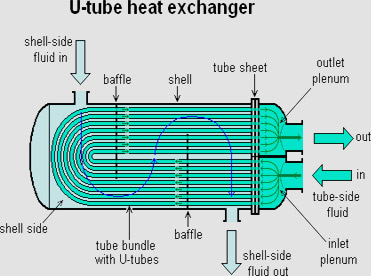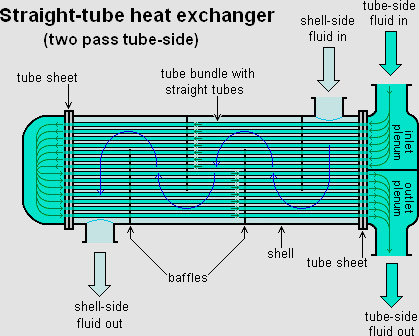
Heat Exchanger Basics:
A shell and tube heat exchanger is just one type of heat exchanger design. It is suited for higher-pressure applications and markets such as: dairy, brewing, beverage, food processing, agriculture, pharmaceutical, bioprocessing, petroleum, petrochemical, pulp & paper, and power & energy.

As its name implies, this type of heat exchanger consists of an outer, elongated shell (large pressure vessel or housing) with a bundle of smaller diameter tubes located inside the shell housing. One type of fluid runs through the smaller diameter tubes, and another fluid flows over the tubes (throughout the shell) to transfer heat between the two fluids. The set of tubes is called a tube bundle, and may be composed of several types of tubes; round, longitudinally finned, etc. depending on the particular application and fluids involved.
There may be variations on the shell and tube design. Typically, the ends of each tube are connected to plenums or water boxes through holes in the tubesheets. The tubes may be straight or bent in the shape of a U, which are called U-tubes.
The selection of material for tubing is extremely important. To be able to transfer heat well, the tube material should have good thermal conductivity. Because heat is transferred from a hot to a cold side through tubes, there is a temperature difference through the width of the tubes. Because of the tendency of the tube material to thermally expand differently at various temperatures, thermal stresses occur during operation. This is an addition to any stress from high pressures from the fluids themselves. The tube material also should be compatible with both the shell and tube side fluids for long periods under the operating conditions (temperatures, pressure, pH, etc.) to minimize deterioration such as corrosion. All of these requirements call for careful selection of strong, thermal conductive, corrosion-resistant, high-quality tube materials. Typical metals used in the manufacturing of heat exchanger tubing include: carbon steel, stainless steel (austenitic, duplex, ferritic, precipitation-hardenable, martensitic), aluminum, copper alloy, non-ferrous copper alloy, Inconel, nickel, Hastelloy, tantalum, niobium, zirconium, and titanium.


Post time: Jul-28-2023
